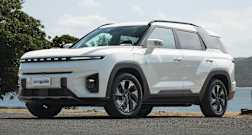In the now oversaturated mainstream small SUV market, there seems to be one particularly poorly filled niche, the sporty SUV.
While there are world-famous hot hatches with decades of pedigree, it seems only just now are manufacturers exploring the bounds of what consumers are willing to ask from an SUV.
We’ve seen full blown entrants like the Hyundai Kona N, but in its predictably conservative manner, Toyota dips its toes in the hot SUV water with this car, the seemingly lightly-warmed-over C-HR GR Sport.
Not everything is as it seems with the C-HR’s latest variant though. Read on to find out why.
Toyota C-HR 2022: Gr-S (2Wd) Hybrid
| Engine Type | Inline 4, 1.8L |
|---|---|
| Fuel Type | Unleaded Petrol/Electric |
| Fuel Efficiency | 4.3L/100km (combined) |
| Seating | 5 |
| Price From | $33,660 - $40,040 |
| Safety Rating |
|
Does it represent good value for the price? What features does it come with?
Value here will depend on how much you appreciate the C-HR’s edgy new look, because it mirrors most of its equipment level to the identically-priced Koba hybrid grade.
Both variants wear MSRPs of $37,665. As the GR Sport is hybrid only, the choice at the price is whether you want the sporty bits this car offers, or the more luxury bits that the Koba offers. I know which I’d pick.
And yes, you read that right, unlike its Hyundai Kona N-Line rival the GR Sport doesn’t get a more powerful engine option, stuck with Toyota’s efficient but somewhat anaemic 1.8-litre hybrid powertrain in front-drive only. More on that later.
.jpg)
Credit where credit is due, at least the GR Sport doesn’t cost more than the Koba, and its standard equipment is great for the small SUV space.
The most immediately noticeable items include the GR Sport bodykit and 19-inch chrome alloy wheels clad in aggressive Yokohama Advan tyres, LED headlights and new fog light clusters, and GR Sport badgework on the front and rear. The only inkling of a performance upgrade is the 15mm lower suspension with a stiffer tune.
.jpg)
Inside, the Koba’s synthetic leather-trimmed seats are swapped out for GR Sport branded synthetic suede sports seats, a new leather-trimmed gear selector, and an aluminium pedal set. Unlike Japanese versions of this car, there’s no new steering wheel or dial cluster.
Items unchanged from its Koba sibling include an 8.0-inch multimedia touchscreen with wired Apple CarPlay and Android Auto connectivity, built-in sat-nav, six-speaker audio, a 4.2-inch digital screen in the dash cluster, keyless entry and push-start ignition, dual-zone climate control, and an auto dimming rear vision mirror. It misses out on the Koba’s heated seats, however.
Safety inclusions are good, too, and while some may be disappointed to hear about the sole hybrid powertrain option, at least it’s frugal. More on these factors later.
Is there anything interesting about its design?
The GR-Sport is very Japanese. While this car’s sporty Korean rivals lean into two-tone trims and blacked out plastics, this wily C-HR goes all Midnight Club with excessive amounts of chrome, a chunky bumper re-work, and big contrasting spoiler bits.
It’s certainly different, and some may like it, but it isn’t for me. Maybe if you really wanted to match your SUV with your Yaris GR in the garage this is the perfect fit.
Tastebuds aside, the C-HR is still a very good-looking small SUV, even several years into its tenure on the Australian market.
During my week with the car, I had several comments on its red lustre and overall design, and surprisingly few on the overwhelming amount of chrome.
.jpg)
Compared to rivals, the C-HR admittedly still cuts a sleek silhouette with the raked roof, tall bonnet line, exacerbated length courtesy of a relatively long wheelbase, and a chiselled rear liftgate with attractive light designs.
It’s contemporary and eye-catching. Inside, this only continues to a degree. The shape of the cabin is comprised of dramatic angles and a swoopy dash.
And like other recent Toyota SUVs, there’s a lot of attention to detail in the pattern work which runs across the dash, into the doors, and even the roof elements carry the rhomboidal pattern which seems to define the C-HR’s character.
.jpg)
Despite this, the interior hardly feels cutting edge, with some average plastics, a monotone colour approach with grey on piano black, and some ordinary touchpoints.
It’s unfortunate to see the analogue dash elements, which combine with the steering wheel for a last-generation feel in the cabin. Aside from the seats, there’s not much in here which differentiates the GR Sport from its siblings.
At least with this car’s 2020 model year update, the lacklustre multimedia screen has been replaced with a far more modern looking and feeling unit.
The cool interior and exterior design treatment also leads into some practicality issues, which we’ll touch on next.

How practical is the space inside?
There are a lot of ways in which the C-HR is more practical than its Corolla hatch sibling, but some areas where it could definitely do better in the small SUV space.
While many will appreciate the ride height on offer from the C-HR, the front of the cabin feels quite claustrophobic thanks to the abundance of black trim, and the design of the dash cladding and centre console means it suffers from the same lack of storage as its Corolla relation.
The big swooping piece of plastic trim down the centre only houses two large bottle holders, a small centre console box, and that’s about it.
.jpg)
Where this area meets the dash, there’s a lot of cladding bits where there should be a storage cutaway. There’s even an odd little shelf, but I’m not sure what it’s for because it’s tiny and hard to access. Odd.
Like the Corolla, this car’s climate controls float atop the angled dash piece, tastefully finished in that signature rhomboidal pattern.
And thankfully the new and improved screen is much easier to use than the small one it replaces from the pre-update model. It even has dials for volume and tuning as well as toggles for temperature and fan speed.
There are decent bottle holders in the doors with smallish pockets, but that’s where storage in the front cabin ends.
.jpg)
The seats are comfortable, adjustable, and offer a decent view of the road up front, although I’m not sure how well the synthetic suede trim will age in this GR Sport compared to the hardy synthetic leather in the Koba.
The back seat is interesting. For a start, the rear door is smaller than the front, another element designed to make the C-HR look and feel more like a coupe than an SUV.
But rear access is impeded further by the common Toyota issue of the door itself not extending anywhere near a 90-degree angle. This may make it tricky to fit child seats or load luggage into the rear row.
The seats continue with the GR Sport synthetic suede, but interestingly the seat base is almost in line with the front seats, instead of significantly elevated like it usually is in a small SUV.
This is good because it leaves plenty of headroom, but the space feels closed-in anyway thanks to the very high belt-line, tiny and heavily tinted rear windows, and abundance of black trim.
It’s hardly the most pleasant place to be as an adult, and kids might not even be able to peer out of the windows they’re so high.
There is, again, a lack of storage for rear passengers, with just a single bottle holder in the doors, small pockets on the back of the front seats, and no power outlets or directional air vents.
Boot space comes in at 318 litres (VDA). That’s small for the segment, but the space is quite useful thanks to the lack of wheel arch claddings on the inside, so it’s more useful than it first appears.
What are the key stats for the engine and transmission?
The C-HR GR Sport has a single engine choice, a 1.8-litre Atkinson-cycle four-cylinder petrol hybrid, which drives the front wheels via a continuously variable automatic transmission.
This engine is renowned for its efficiency and ease-of-use, but with just 90kW of combined power output, it seems to fly in the face of what this car is trying to communicate from the outside.
.jpg)
It’s not just the powertrain either. There are no performance enhancements to be found anywhere. No bigger brakes and barely tweaked suspension. This car represents Toyota’s Gazoo Racing (GR) in name only.
How much fuel does it consume?
Toyota’s 1.8-litre Atkinson-cycle hybrid engine is renowned for its fuel efficiency, and on this front at least the C-HR GR Sport delivers.
It has an official combined cycle fuel consumption figure of 4.3L/100km which is excellent. And on my week-long test which had a good mix of freeway and urban driving the car’s computer returned a real-world figure of 5.1L/100km.
I think any other small SUV would have trouble beating that, even Subaru’s hybrid XV couldn’t best 7.3L/100km in my most recent long-term test.
You can fuel the GR Sport’s 43-litre tank with base-grade 91RON unleaded petrol.
Warranty & Safety Rating
What safety equipment is fitted? What safety rating?
All C-HRs get auto emergency braking (with pedestrian detection), adaptive cruise control, lane departure warning with lane keep assist, blind spot monitoring with rear cross traffic alert, and traffic sign recognition. Not class leading, but pretty good on the active front.
.jpg)
There are also seven airbags (the standard front, side, and head pairs, plus a driver’s knee) and the usual electronic brake, traction, and stability aids, which helped score the C-HR a maximum five-star ANCAP safety rating, although it is to an older 2017 standard.
There are three top tether and two ISOFIX child seat mounting points across the rear row, and even this GR Sport grade scores a space-saver spare wheel under the boot floor.
What does it cost to own? What warranty is offered?
The C-HR range is covered by Toyota’s five year and unlimited kilometre warranty, while the hybrid battery components are covered for up to 10 years.
The servicing, as with most current Toyota models, is a real strong point, with each service due every 12 months or 15,000km coming in at just $200 for the first four services.
The best in the small SUV segment? Unless you count some full-electric models which offer free servicing, then yes, it is.
What's it like to drive around town?
If you’ve driven any recent Toyota hybrid model, not much is amiss here. This might come as a surprise given the aggro looks of the GR Sport from the outside, but from behind the wheel it’s remarkably tame.
In fact, I’d say it’s far too tame, with this car sharing the same problem as the rest of the C-HR range, in that it feels underpowered.
To make matters worse, if anything the big chrome wheels and lower, harder suspension ruin an otherwise pleasant ride, adding a fair bit of extra sharpness and unpleasant road feel compared to other variants in the range.
It’s not worth the trade-off. This car doesn’t feel quick, just the same but with a measurably worse ride, and little extra positives in the way of feel or handling. The smooth ride of the identically-priced Koba is far preferable in my opinion.
.jpg)
Still, the 1.8-litre four-cylinder engine paired with this hybrid electric set-up remains one of the best on the market, with its seamless blend of silent and smooth electric torque delivery and the backup of the engine. Just don’t expect it to be rapid.
Like most recent Toyotas which share the 'TNGA' chassis philosophy, the steering tune is lovely, balancing low-speed ease with high-speed feel, and the wheels all the way out to the edges of the chassis make for a solid amount of grip on the road, all-wheel drive or not. If nothing else, the C-HR handles a fair bit better than most of its rivals.
Visibility is a tad limited out the rear no thanks to that high spoiler lip of the tailgate, and the high belt line generally means on occasion you’ll be trying to peer over the nose or sides to make sure everything is aligned in parking scenarios.
.jpg)
Of course, making the most of Toyota’s signature hybrid drive is central to the experience of driving this car, and it’s foolproof.
The analogue dial cluster will help guide you with the first ‘eco’ bar essentially being the purely electric part of the acceleration journey, with the engine entering further up as more is required, and as it reaches its peak, the electrical assistance comes back in to give it a slight boost.
Interestingly, the C-HR has slightly different software from the Corolla, replacing the hybrid coach with a percentage of purely electric drive per trip which is a telling feature. Stuck in traffic? Expect some 60 per cent electric. Think of all the fuel you’ll save.
On a final note, the C-HR shares the same issue with all Toyota hybrids, in that it misses a lot of the efficiency on the freeway, and the rattly Atkinson-cycle engine is quite loud when pushed, breaking that semi-electrified immersion you’ll become used to around town.
Verdict
If you love the look of Toyota’s emerging GR Sport range, but when it comes down to it you just need a frugal car to kick around town, the C-HR GR Sport fills that oddly specific niche. For those who prefer comfort over looks, there’s always the identically-priced Koba hybrid, which would still be my pick of the range.
Pricing Guides








.jpg)

.jpg)
.jpg)
.jpg)
.jpg)













.png)

.png)

.png)














.png)

.png)






.png)
.jpg)

